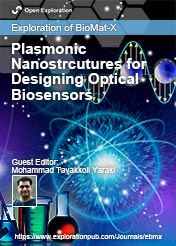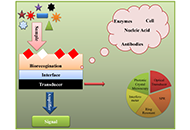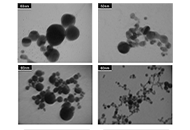-
 Special Issue Topic
Special Issue TopicPlasmonic Nanostructures for Designing Optical Biosensors
Submission Deadline: June 30, 2025Guest Editor
Mohammad Tavakkoli Yaraki E-Mail
Macquarie University Research Fellow (MQRF) at School of Natural Sciences, Faculty of Science and Engineering, Macquarie University, Sydney, Australia.
Research Keywords: plasmonics; nanoparticles; biosesnor; drug delivery; nanocomposite; cancer therapy
About the Special Issue
To date, plasmonic nanostructures in various forms (i,e., colloidal and planar) have been designed and developed. These nanostructures have been used in designing optical biosensors for ultrasensitive and selective detection of wide ranges of analytes from ions and small molecules to proteins and even live cells such as human and bacteria.
The last decade has seen advances in the design of these nanostructures, not only in their synthesis but also in surface functionalization approaches. Through this progress, various characterization techniques have also been employed to indicate their successful synthesis as well as the successful surface modification to enhance the selectivity of the system towards specific analyte. These optical biosensors have been used for diagnosis and prognosis of severe disseises as well as biologically important molecules from the in vitro to in vivo level.
Moreover, different theoretical modelling/calculation/simulation methods, including but not limited to density functional theory, molecular docking, molecular dynamics, Monte Carlo, etc., have been used to investigate the optical properties of plasmonic nanostructures as well as the interactions of molecules with surface of plasmonic nanostructure at the molecular level, leading to better insight into these systems.
Suggested topics include, but are not limited to:
★ The synthesis of various forms of plasmonic nanostructures by top-down or bottom-up approaches
★ The surface functionalization of plasmonic nanostructures for enhanced selectivity
★ Multifunctional plasmonic nanostructures
★ In vitro, in vivo, and in silico studies on optical biosensors
★ Stability of plasmonic nanostructures in biological media
★ Plasmonic nanostructures with therapeutic effects
★ Plasmonic nanostructures with theragnostic effects
★ Plasmon-enhanced processes (metal-enhanced fluorescence, metal-enhanced singlet oxygen generation, Surface-enhanced Raman scattering)
Keywords: plasmonic; nanostructure; nanoparticle; biosensor; colorimetric; SERS; fluorescence; synthesis; fabrication; modelling
Call for Papers
Published Articles
 Photonic silver iodide nanostructures for optical biosensorsOpen AccessReviewSilver iodide (AgI) nanostructures have been considered as promising candidates for optical biosensors owing to their optical characteristics of optical properties, including tunable surface plasmon [...] Read more.Humaira Aslam ... Misbah Ullah KhanPublished: December 13, 2024 Explor BioMat-X. 2024;1:366–379
Photonic silver iodide nanostructures for optical biosensorsOpen AccessReviewSilver iodide (AgI) nanostructures have been considered as promising candidates for optical biosensors owing to their optical characteristics of optical properties, including tunable surface plasmon [...] Read more.Humaira Aslam ... Misbah Ullah KhanPublished: December 13, 2024 Explor BioMat-X. 2024;1:366–379
DOI: https://doi.org/10.37349/ebmx.2024.00025 Spectrum reconstruction of experimentally produced nano-colloids using Mie theoryOpen AccessOriginal ArticleAim: Synthesis of plasmonic nanoparticles, characterization, size detection by modeling. Methods: Colloidal plasmonic gold and silver nanoparticles were prepared by laser ablation with a 1, [...] Read more.Hamid Nadjari, Hadi MovahedinejadPublished: October 22, 2024 Explor BioMat-X. 2024;1:289–299
Spectrum reconstruction of experimentally produced nano-colloids using Mie theoryOpen AccessOriginal ArticleAim: Synthesis of plasmonic nanoparticles, characterization, size detection by modeling. Methods: Colloidal plasmonic gold and silver nanoparticles were prepared by laser ablation with a 1, [...] Read more.Hamid Nadjari, Hadi MovahedinejadPublished: October 22, 2024 Explor BioMat-X. 2024;1:289–299
DOI: https://doi.org/10.37349/ebmx.2024.00021 -
-
Ongoing Special Issues